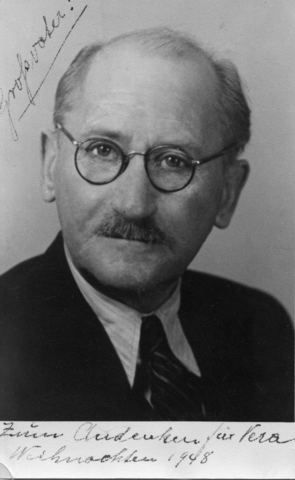Name Hermann Hartmann | Books New Concepts III. | |
 | ||
Died October 22, 1984, Glashutten, Germany | ||
Hermann Hartmann (May 4, 1914 – October 22, 1984) was a German chemist and professor and researcher in physical and theoretical chemistry at the University of Frankfurt am Main. He contributed to all fields of physical chemistry and was instrumental in establishing theoretical chemistry by developing Ligand field theory (1947) and other quantum chemical models including the Hartmann Potential (1971). He also formulated a new perturbation theory (1970–1977) as part of his pioneering research towards a unified field theory of chemical bonding based on a non-linear Schrödinger equation (1980).
Contents

Biography
Hermann Hartmann has been a universal personality with highly developed intuition, admired as an excellent teacher and author of more than 250 scientific papers published in journals of physical and theoretical chemistry.
1933–1952
In 1933 H. Hartmann started the study of chemistry in Munich, where he got strongly influenced and supported by Arnold Sommerfeld. 1939 he continued his studies in Frankfurt where he received his PhD 1941. In 1943 he habilitated on the applications of the Hückel theory. 1946 he became Docent in Frankfurt. Together with F. Ilse, his first student, he developed Ligand field theory a mayor advance in the understanding of complex compounds. In 1951 he became leader of a division in the Max-Planck-Institute for Physical Chemistry in Göttingen but returned to Frankfurt a year later.
1952–1962
1952 Hartmann was appointed as Director of the Institute of Physical Chemistry at the University of Frankfurt. His research covered all areas of physical and theoretical chemistry. In his spectroscopic studies he applied all available techniques from x-ray, optical, infrared, microwave, NMR to mass spectrometry. His investigations of kinetic processes include reactions with peptides, organic radicals as well as studied on the influence of pressure and solvation. In his theoretical work Hartmann emphasis on exact solvable models (model quantum chemistry) rather than numerical ab initio calculations . His main book „Quantum mechanical theory of chemical bonding“ ( "Theorie der chemischen Bindung auf quantentheoretischer Grundlage") appeared 1954. Through his publications and lectures he influenced considerably the development of quantum chemistry in Germany.
1962–1972
Through the support of the German Research Foundation (DFG) in the early 60th Hartmann could expand his group of researchers. Among the 20 theoreticists and about 100 scientists working and teaching at Hartmann's Institute were H. L. Schläfer, G. Gliemann, H. Sillescu, G.H. Kohlmeier, K. Helfrich, E. A. Reinsch, H. v. Hirschhausen, K. Jug, J. Heidberg, H. Heydmann, H. Kelm, H. W. Spiess.
With the support of his group Hartmann focused on getting students interested in theoretical chemistry by arranging regular summer schools in theoretical chemistry held mostly at Konstanz/Bodensee.
1962 Hartmann started Theoretica Chimica Acta a peer-reviewed scientific journal publishing original research and review articles in theoretical chemistry. Articles could be submitted in English, German, French and also Latin, but only one article was ever written in Latin. 1984 shortly before his death Hartmann turned the editorship over to K. Ruedenberg, Iowa State University. After Ruedenberg's retirement 1997, the name of Theoretica Chimica Acta (TCA) was broadened to Theoretical Chemistry Accounts: Theory, Computation, and Modeling, still keeping its initials TCA, with the new editor Donald G. Truhlar, University of Minnesota. TCA documents the growth of the field of theoretical chemistry and contributed significantly to the progress of theoretical chemistry in Germany.
1965 Hartmann organized the first Theoretical Chemistry Symposia ( "Symposium für Theoretische Chemie"). The initial goal of the annual meetings was to provide a regular platform for theoreticians from Germany, Austria, and Switzerland to meet with experimentalist. In the organization committee Hartmann was supported by H. Labhart (Zürich), and 0.E. Polansky (Vienna) – to which at a later time W.A. Bingel (Göttingen), E. Ruch (Berlin), G. Wagniere (Zürich), and P. Schuster (Vienna) were added. Since 1992 the symposium organizer is selected by the Arbeitsgemeinschaft Theoretische Chemie (AGTC), founded to give this field a more official status in concert with the established professional organizations of chemistry, physical chemistry, and physics. The symposium is since then the annual meeting for theoretical chemists from the German speaking countries The location of these meetings varies in the series between Germany-Switzerland-Germany-Austria.
Through all the efforts initiated by H. Hartmann theoretical chemistry started to influence not only chemical research in Germany but slowly became an independent field for which new professorships were created at universities.
1972–1984
In the 70th experimental research at the Hartmann Institute of physical chemistry focused on ion-molecule reactions using ion-cyclotron resonance spectroscopy with K.-P. Wanczek as leading researcher who 1976 became Professor at the University of Bremen. The theoretical foundations of this research were developed in collaboration with K.-M.. Chung, M. W. Morsy, and D. Schuch theoretical physicists working at Hartmann's Institute for Theoretical Chemistry. Since 1973 H. Hartmann also had a small research institute at his place of living in Glashütten (Taunus) supported by the Mainzer Akademie der Wissenschaften und Literatur. Together with K.-M. Chung, D. Schuch, W. Ulmer and B. Zeiger a unified understanding of molecular interactions was developed based on a nonlinear Schrödinger equation. Hartmann thereby pioneered the discovery of one self-interacting field as the foundation of chemistry. H. Hartman emerited in 1982 and died two years later.
H. Hartmann was honoured as member of the Deutsche Akademie der Naturforscher Leopoldina, the Gesellschaft Österreichischer Chemiker, the Accademia Nazionale die Lincei, the Royal Danish Academy of Sciences and Letters, the Comitato Premio of Fondazione Balzan, the International Academy of Quantum Molecular Science, and the Akademie der Wissenschaften und der Literatur zu Mainz.
